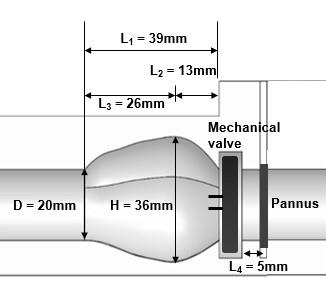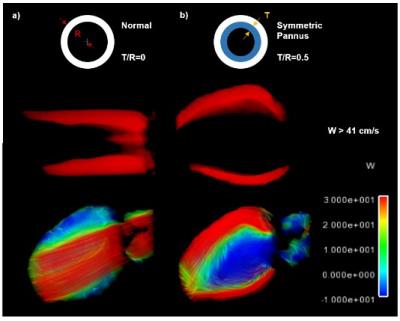Hyung Kyu Huh1, Hojin Ha1, Sang Joon Lee1, Namkug Kim2,3, and Donghyun Yang3
1Mechanical Engineering, POSTECH, Pohang, Korea, Republic of, 2Department of Convergence Medicine, Asan Medical Center, 3Department of Radiology, Asan Medical Center
Synopsis
A
pannus formation is a growth of abnormal tissues around the heart valve, which
is often found in patients whom underwent heart valve replacement surgery. Significant
hemodynamic changes caused by the formation of the pannus may contribute to the
failure of the valves even without direct contact to the leaflets. In current
study, flow in the sinus if Valsalva under subvalvular pannus formation was
analyzed using in vitro phantom and
4D flow MRI. Symmetric pannus causes imperfect opening the valve, which might
lead to the heart failure.
Introduction
A pannus formation is a growth
of abnormal tissues around the heart valve, which is often found in patients whom
underwent heart valve replacement surgery. Formation of pannus may dysfunction
the replaced valves, which impose repeated open surgery of the heart[1].
Subprosthetic panni formation in patients with chest discomfort after valve
replacement was observed by Han et al.[2] using cardiac computed
tomography. Apart from the direct contact of pannus with prosthetic valves,
significant hemodynamic changes may also contribute to the failure of the
valves even without direct contact to the leaflets. However, due to the
limitation in in vivo visualizing of
the flow characteristics, dysfunction related with the flow characteristics are
not fully understood yet. In current study, flow in the sinus if Valsalva under
subvalvular pannus formation was analyzed using in vitro phantom and 4D flow MRI. Methods
An in vitro sinus phantom which geometry was based on the human data
used in the study of Yagi et al.[3] was printed using 3D printer(Objet500
connex3, Stratasys, Eden Prairie, MN, USA) (Fig.1). The St-Jude prosthetic
valve of 19.6mm diameter was placed in front of the aortic sinus. Two different
types of pannus (symmetric and asymmetric) was installed 5mm in front of the
prosthetic valve. T/R=0, 0.1, 0.2, 0.3, 0.4 and 0.5, where T is thickness of
the pannus and R is the radius of the tube was used in current experiment. Steady
flow rate of 6 and 12 L/min was applied, which represents mean flow rate and systolic
flow rate in human aorta, respectively. Pulsatile flow was also applied in 60bpm.
Image acquisition was performed on 3T scanner (MAGNETOM Skyra, Simens, Germany)
with velocity encoding range (VENC) of 80 and 180 for 6 and 12 L/min,
respectively.Results
Three distinctive jet flow of
which velocity was higher than 41cm/s was found behind the prosthetic
mechanical valve without pannus formation (T/R=0). Valve was widely opened, and
recirculating flow was observed inside apices (Fig.2a). When symmetric pannus
with T/R=0.5 was placed in front of the prosthetic valve, jet flow was developed
toward the upper and lower parts of the Sinus and strong regurgitating flow was
found in the center region of the Sinus (Fig.2b). Regurgitating flow was also
confirmed at the pulsatile flow condition, indicating the failure of the valve
function (data not shown). Lower jet was significant than upper jet for the
case of asymmetric pannus with T/R=0.5 as shown in Fig.4a. As the asymmetric
pannus was rotated for 45 degree, jet is shifted toward the side wall where
pannus was not formed (Fig.4b). The shifting of the jet was more significant as
the asymmetric pannus was rotated 90 degree. Discussion
Regardless of direct contact
of pannus with the leaflets, failure of the prosthetic mechanical valve occurs
when symmetric pannus is formed. This will increase the pressure inside the
heart and it may cause heart failure. Also, high wall shear stress applied on
the upper and lower walls of the Sinus may cause dilation. Imperfect opening of
the valve is mainly due to the center focused flow formed behind the pannus. Leaflets
of the bileaflet valves are fixed with the hinges, and it is opened when
momentum is applied on the cross section area near the peripheral. However, center
focused flow transfer its momentum on the central region of the valve, which
compensates the opening momentum to maintain valves to be partially opened.
Also, large recirculating flow in the center of the sinus applies resistant
force to the valve opening. For the case of asymmetric pannus, strong
recirculation at the upper apex press down the upper leaflet, which leads to
the opening of the valve. Also, formation of the rotated asymmetric pannus applies
non-axisymmetric wall shear stress, which can cause asymmetric Sinus dilation. Conclusion
Pannus formation and its shape,
severity and rotational angle have great influence on the flow characteristics
inside the Sinus. High wall shear stress applied on the wall may lead the
dilation of Sinus. More importantly, flow characteristics plays significant
role on the function of the prosthetic valve, which may cause heart failure. 4D
MRI have strong potential to visualize and quantify 3D flow inside the sinus of
real patient with prosthetic heart valve. Understanding the flow characteristics
will be helpful to decide whether patient requires repeated open surgery. Acknowledgements
No acknowledgement found.References
[1]
Chung MS, Yang DH, Kim DH, et al. Eur Heart J-Card Img (2015) [2] Han K, Yang
DH, Shin SY, et al. Radiology (2015) [3] Yagi T, Yang W, Umezu M. Journal of
Biomechanical Science and Engineering (2011)


